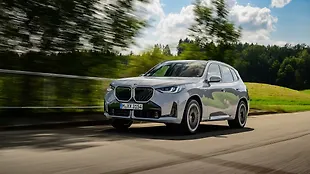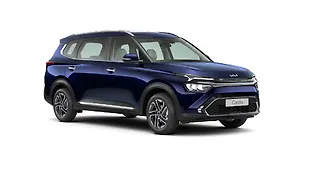Why would I buy it?
- Strong performance
- Fuel-efficient drivetrain
- Features
Why would I avoid it?
- Lacks rear seat space
- Slightly firm ride
What is it?
7.5 / 10

Kia India has always been proactive in refreshing its limited lineup of cars. There are model year updates with essential improvements and a little something extra on top of the model range in the form of the X Line trim. Now I know the X Line treatment is incoming for the Sonet (Kia has teased it, after all, and you can read about it here) but what we have is the 2022 model year update that has made the Sonet an even better everyday car. So what’s new, then?

There are new colour options for select variants on the 2022 Sonet. There’s a nice subtle shade of blue called Imperial Blue and another silver option, although the car you see here is finished in Intense Red, and that colour has been around for some time. Other than this, there are no changes to the design or the dimensions of the 2022 Sonet.
What’s it like inside and what do you get?
7.5 / 10

When the Sonet was first introduced, it had Kia’s connected tech called UVO connect, which is now rebranded to KIA connect. The latter is what you get inside the 2022 Sonet. More importantly, Kia has upgraded the safety features by offering four airbags and a tyre pressure monitoring system as standard on all variants. Better still, the top-spec HTX+ and GTX+ variants continue to come with six airbags. The rest of the features and the overall look have been retained for the 2022 model range.
Its Seltos-like console that integrates the infotainment system and the driver’s display looks nice. And the quality of material used all around the cabin is good, too. We like the tactile feel of all the buttons – be it for the air-con unit or on the steering wheel. The flat-bottom steering in the GT line isn’t meaty but feels nice to hold. Behind it, the instrument cluster has a digital speedometer with analogue dials on either side; however, these dials are extremely small and are difficult to see on the move. The touchscreen is as smooth and intuitive as ever, and the infotainment system is bundled with plenty of feel-good features.

The driver's seat is manually adjustable for height and, overall, offers good support. And though the steering only adjusts for rake and not reach, finding a suitable driving position isn’t difficult. With sorted ergonomics and thin A-pillars, the visibility outside is good, too.

Moving to the rear seats, the bench has good back support on offer, but the seat base could have done with some extra under-thigh support to feel more comfortable. While the scooped roof helps with ample headroom, legroom is just about adequate. Accommodating three here won’t be a comfortable affair either, thanks to the tight shoulder room. Not only is the Sonet’s cabin a nice place to be in, but it is also one of the most feature-loaded in the segment. Standout features include – six airbags, ventilated seats, connected car tech with voice commands, an integrated air purifier, a seven-speaker Bose music system, mood lighting, TPMS, and drive/traction modes.

What’s it like to drive?
8 / 10

The Sonet gets a long list of engine and powertrain options. There’s a 1.0-litre turbo petrol, a 1.2-litre naturally aspirated petrol and a 1.5-litre turbo diesel engine. The gearbox options are even more comprehensive and what we have is the 1.0-litre turbo with the seven-speed dual-clutch automatic pushing out 120bhp and 172Nm of torque. For a three-cylinder unit, this engine is very refined and pretty lively. At city speeds, all you need is part throttle to get ahead of traffic, and for times when you need to up the pace, the engine delivers enough poke post 2,500rpm. It’s not the nicest sounding engine when revved hard – in fact, the typical three-cylinder thrum is not as pleasant as the one on Volkswagen’s one-litre TSI unit. It’s just better to upshift between the 3,500 and 4,000rpm mark and ride the torque wave because mid-range is where this engine performs the best and makes everyday driving effortless.

You also get drive and traction modes which are reserved for the automatic variants only. Talking about the gearbox, the dual-clutch unit isn’t lurchy at low speeds, which we particularly liked. On the move, it goes about its business of shifting gears smoothly with hardly any lag when you put it in Sport. Now we have seen that the Sonet is quite well accepted by the younger audience, most of who enjoy driving. And to continue to make it a good driver’s car, Kia has retained the suspension setup, which is slightly firm for everyday usage – you can feel the imperfections of the roads, in general, more than you would like and even when you up the pace there is some underlying stiffness. Overall, the ride quality is not jarring at all and, in fact, good for the most part.

How does it compare and what’s the price?
7.5 / 10

The 2022 Sonet range starts at Rs 7.49 lakh ex-showroom and goes all the way to Rs 13.89 lakh. The GTX+ automatic variant you see here is priced at Rs 13.29 lakh. As for its rivals, the Sonet is placed in one of the most competitive segments, which includes cars like the Maruti Suzuki Brezza, Tata Nexon and the Hyundai Venue.
Pictures by Kapil Angane

![Kia Sonet [2022-2023] Right Front Three Quarter Kia Sonet [2022-2023] Right Front Three Quarter](https://imgd.aeplcdn.com/642x361/n/cw/ec/129405/kia-sonet-right-front-three-quarter32.jpeg?isig=0&wm=1&q=80)
![Kia Sonet [2022-2023] Right Front Three Quarter Kia Sonet [2022-2023] Right Front Three Quarter](https://imgd.aeplcdn.com/642x361/n/cw/ec/129405/kia-sonet-right-front-three-quarter1.jpeg?isig=0&wm=1&q=80)
![Kia Sonet [2022-2023] Right Front Three Quarter Kia Sonet [2022-2023] Right Front Three Quarter](https://imgd.aeplcdn.com/642x361/n/cw/ec/129405/kia-sonet-right-front-three-quarter19.jpeg?isig=0&wm=1&q=80)
![Kia Sonet [2022-2023] Right Side View Kia Sonet [2022-2023] Right Side View](https://imgd.aeplcdn.com/642x361/n/cw/ec/129405/kia-sonet-right-side-view17.jpeg?isig=0&wm=1&q=80)
![Kia Sonet [2022-2023] Right Rear Three Quarter Kia Sonet [2022-2023] Right Rear Three Quarter](https://imgd.aeplcdn.com/642x361/n/cw/ec/129405/kia-sonet-right-rear-three-quarter4.jpeg?isig=0&wm=1&q=80)
![Kia Sonet [2022-2023] Right Rear Three Quarter Kia Sonet [2022-2023] Right Rear Three Quarter](https://imgd.aeplcdn.com/642x361/n/cw/ec/129405/kia-sonet-right-rear-three-quarter20.jpeg?isig=0&wm=1&q=80)
![Kia Sonet [2022-2023] Left Rear Three Quarter Kia Sonet [2022-2023] Left Rear Three Quarter](https://imgd.aeplcdn.com/642x361/n/cw/ec/129405/kia-sonet-left-rear-three-quarter25.jpeg?isig=0&wm=1&q=80)
![Kia Sonet [2022-2023] Left Rear Three Quarter Kia Sonet [2022-2023] Left Rear Three Quarter](https://imgd.aeplcdn.com/642x361/n/cw/ec/129405/kia-sonet-left-rear-three-quarter9.jpeg?isig=0&wm=1&q=80)
![Kia Sonet [2022-2023] Image Kia Sonet [2022-2023] Image](https://imgd.aeplcdn.com/272x153/n/cw/ec/115451/sonet-exterior-right-front-three-quarter.jpeg?isig=0&q=80)

























